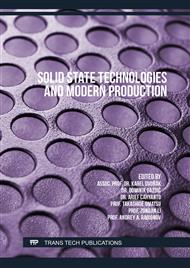p.55
p.65
p.73
p.81
p.89
p.97
p.103
p.109
p.117
Dependence of Lignosulfonate Plasticizer Efficiency on the Activator Concentration in Alkali-Activated Blast Furnace Slag Paste
Abstract:
Alkali-activated materials are a low carbon alternative for Ordinary Portland cement in the building industry. However, the effectiveness of commercially available cementitious plasticizers is often an issue. The present study deals with the workability, setting time, and mechanical properties of alkali-activated blast furnace slag (AAS) systems with different addition of lignosulfonate plasticizer (0; 0.5 and 1.0%) and various concentrations of alkaline activator (sodium hydroxide with concentration of Na+ ranging from zero to 12 mol∙dm−3 was used for these purposes). The workability of AAS was determined using the slump test according to EN 1015-3. Then the Vicat apparatus as described in EN 196-3 was used for measurement of the setting time. The effect of activator dose and plasticizer addition on the mechanical properties was determined using the determination of compressive and tensile strength in bending. A positive effect of the addition of a plasticizer in a certain concentration range on the workability was observed, but at the same time, the setting time is prolonged. The optimal concentration of NaOH seems to be of 2–4 mol∙dm−3 regarding the development of mechanical properties and workability.
Info:
Periodical:
Pages:
89-95
Citation:
Online since:
October 2022
Authors:
Price:
Сopyright:
© 2022 Trans Tech Publications Ltd. All Rights Reserved
Share:
Citation:



